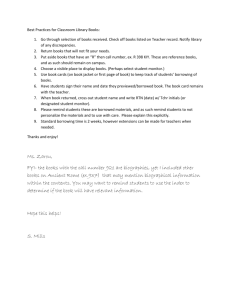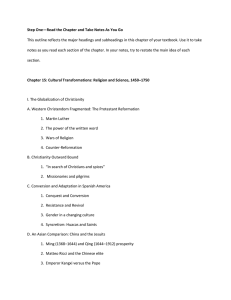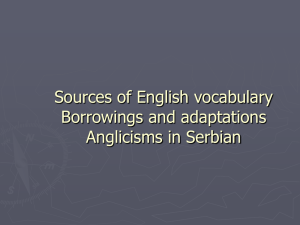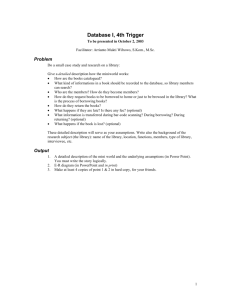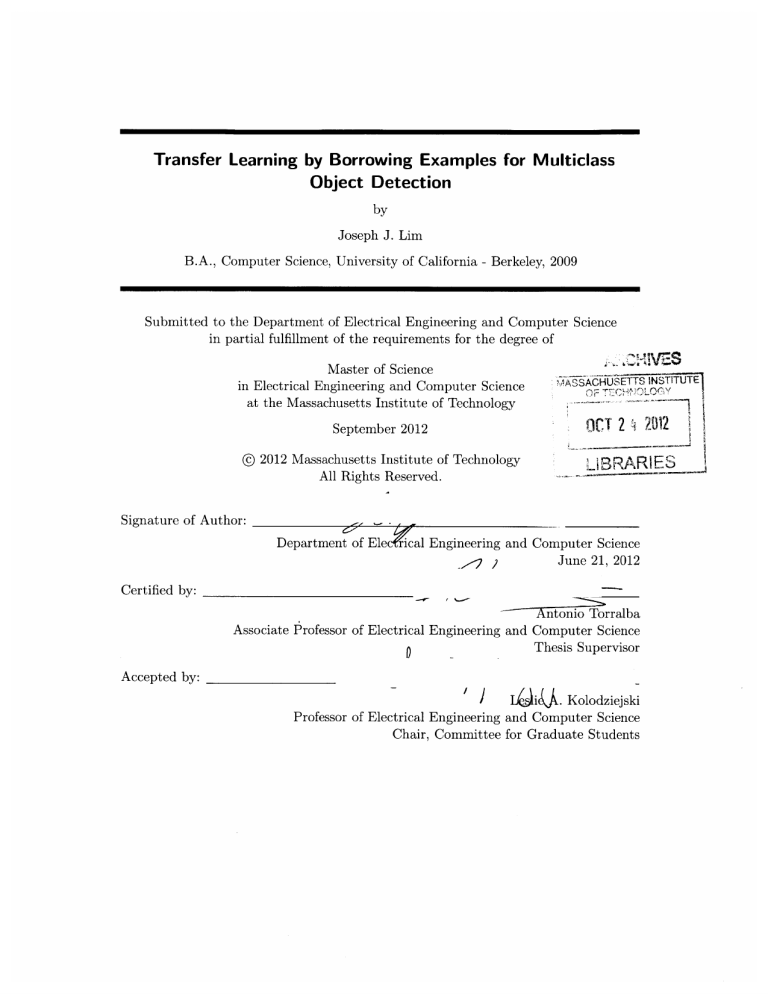
Transfer Learning by Borrowing Examples for Multiclass
Object Detection
by
Joseph J. Lim
B.A., Computer Science, University of California - Berkeley, 2009
Submitted to the Department of Electrical Engineering and Computer Science
in partial fulfillment of the requirements for the degree of
Master of Science
in Electrical Engineering and Computer Science
at the Massachusetts Institute of Technology
MASSC
INSTITUTE
L9BC
September 2012
@ 2012 Massachusetts Institute of Technology
All Rights Reserved.
LI3RAF(IF
Signature of Author:
Department of Elec(rical Engineering and Computer Science
,--2 )June
21, 2012
Certified by:
Antonio
Torralba
Associate Professor of Electrical Engineering and Computer Science
Thesis Supervisor
Accepted by:
I
ik . Kolodziejski
Professor of Electrical Engineering and Computer Science
Chair, Committee for Graduate Students
2
Transfer Learning by Borrowing Examples for Multiclass Object Detection
by Joseph J. Lim
Submitted to the Department of Electrical Engineering and Computer Science
in partial fulfillment of the requirements for the degree of
Master of Science
Abstract
Despite the recent trend of increasingly large datasets for object detection, there still
exist many classes with few training examples. To overcome this lack of training data
for certain classes, we propose a novel way of augmenting the training data for each
class by borrowing and transforming examples from other classes. Our model learns
which training instances from other classes to borrow and how to transform the borrowed examples so that they become more similar to instances from the target class.
Our experimental results demonstrate that our new object detector, with borrowed
and transformed examples, improves upon the current state-of-the-art detector on the
challenging SUN09 object detection dataset.
Thesis Supervisor: Antonio Torralba
Title: Associate Professor of Electrical Engineering and Computer Science
3
4
Acknowledgments
I would first like to thank my advisor, Professor Antonio Torralba. Not only has he
been a great mentor for conducting scientific research, but also his endless passion and
enthusiasm toward Computer Vision has been a great inspiration.
I would also like to thank to many of my previous advisors: Professor Jitendra Malik
and Professor Max Welling, and my collaborators: Pablo Arbeliez, Myung Jin Choi,
Chunhui Gu, Ruslan Salakhutdinov. They gave a big motivation on every problem I
worked on. Also, MIT visionaries, Roger Grosse, Aditya Khosla, Tomasz Malisiewicz,
Andrew Owens, Carl Vondrick, Jianxiong Xiao, Jenny Yuen, helped me going through
many research obstacles by brain-storming and working together all day and night.
The National Science Foundation funded my research between 2009-2012 by the
NSF Graduate Research Fellowship. I would like to thank to them for awarding the
fellowship.
My parents, Bonguk and Kyungsun, and my brother, Yongwhan, always have been
an ultimate source of encouragement and I would like to thank for their tremendous
love, trust, and guide. Without them, I would never have been able to fall in love with
research.
Thank to my wife, Eunice (Eunjee), for her unconditional love and support that
enabled me do what I love to do always.
p.s. I would also like to thank to Vision0l-Vision37, continent, and day machines
for their dedicated work for 24 hours, 365 days.
5
6
Contents
Abstract
3
Acknowledgments
4
List of Figures
9
1
Introduction
11
2
Learning to Borrow Examples
2.1 Loss Function for Borrowing Examples . . . . . . . . . . . . . . . . . . .
2.2 Learning . . . . . . . . . . . . . . . . . . . . . . . . . . . . . . . . . . . .
15
15
17
3
Borrowing Transformed Examples
3.1 Translation and scaling . . . . . . . . . . . . . . . . . . . . . . . . . . .
3.2 Affine transformation . . . . . . . . . . . . . . . . . . . . . . . . . . . . .
19
19
19
4
Experimental Results
4.1 Borrowing from Other Classes . . . . . . . . . . . . . . . . . . . . . . . .
4.2 Borrowing from Other Datasets . . . . . . . . . . . . . . . . . . . . . . .
21
22
25
5
Conclusion
29
Bibliography
31
7
8
CONTENTS
List of Figures
1.1
2.1
3.1
4.1
4.2
An illustration of training a sofa detector by borrowing examples from
other related classes in the dataset. Our model can find (1) good examples to borrow, by learning a weight for each example, and (2) the best
transformation for each training example in order to increase the borrowing flexibility. Transformed examples in blue (or red) box are more
similar to the sofa's frontal (or side) view. Transformed examples, which
are selected according to their learned weights, are trained for sofa together with the original sofa examples. (X on images indicates that they
have low weights to be borrowed)
. . . . . . . . . . . . . . . . . . . . .
12
Learning to borrow for the target truck class: Learned weights
wtruck for 6547 instances using (a) L 1-norm; (b) Q(.) regularization; and
(c) Q(.) with symmetric borrowing constraint. . . . . . . . . . . . . . . .
17
Illustration of Transformation: Each example is transformed into
different candidate aspect ratios so that they can look most alike with
the target class. The transformation with the smallest Loss(.) is selected
for borrow ing. . . . . . . . . . . . . . . . . . . . . . . . . . . . . . . . . .
20
Performances on varied number of original training examples:
We varied the number of original-only training examples and tested on
the same test set. The performances have a log-linear increasing trend
against the number of training examples. . . . . . . . . . . . . . . . . .
Borrowing Weights: Examples are ranked by learned weights, w: (a)
shelves examples to be borrowed by the bookcase class and (b) chair
examples to be borrowed by the swivel chair class. Both show that
examples with higher w are more similar to the target class. (green:
borrowed, red: not borrowed) . . . . . . . . . . . . . . . . . . . . . . . .
22
22
9
10
LIST OF FIGURES
4.3
4.4
4.5
4.6
(a) Number of examples used for training per class before borrowing
(blue) and after borrowing (red). Categories with fewer examples tend
to borrow more examples. AP improvements (b) without and (c) with
transformations, compared to the single detector trained only with the
original examples. Note that our model learned to borrow from (b) 28
classes, and (c) 37 classes.
. . . . . . . . . . . . . . . . . . . . . . . . .
Detection results on random images containing the target class. Only
the most confident detection is shown per image. For clearer visualization, we do not show images where both detectors have large overlap.
Our detectors (2nd/4th row) show better localizations than single detectors (1st/3rd row). (red: correct detection, yellow: false detection) . . .
SUNO9 borrowing PASCAL examples: (a) Typical SUN09 car images, (b) Typical PASCAL car images, (c) PASCAL car images sorted
by learned borrowing weights. (c) shows that examples are sorted from
canonical view points (left) to atypical or occluded examples (right).
(green: borrowed, red: not borrowed) . . . . . . . . . . . . . . . . . . .
Highest and Lowest borrowing weight examples: We show three
different borrowing relationships (sofa, car, and chair). Green box shows
top examples borrowed, and red box shows worst examples (hence not
borrow ed). . . . . . . . . . . . . . . . . . . . . . . . . . . . . . . . . . . .
23
24
25
26
Chapter 1
Introduction
C
containing
using a database of annotated images
detector
a sofaclasses,
sofas
andbuilding
many other
INSIDER
as shown in Figure 1.1. One possibility would be
to train the sofa detector using only the sofa instances. However, this would result in
somewhat poor performance due to the limited size of the training set. An alternative
is to build priors about the appearance of object categories and share information
among object models of different classes. In most previous work, transfer of information
between models takes place by imposing some regularization across model parameters.
This is the standard approach both in the discriminative setting [1, 2, 14-17, 20, 21, 28]
and in generative object models [3, 8, 9, 19, 24, 25].
In this thesis, we propose a different approach to transfer information across object
categories. Instead of building object models in which we enforce regularization across
the model parameters, we propose to directly share training examples from similar categories. In the example from Figure 1.1, we can try to use training examples from other
classes that are similar enough in appearance, for instance armchairs. We could just
add all the armchair examples to the sofa training set. However, not all instances of
armchairs will look close enough to sofa examples to train an effective detector. Therefore, we propose a mechanism to select, among all training examples from other classes,
which ones are closer to the sofa class. We can increase the number of instances that
we can borrow by applying various transformations (e.g., stretching armchair instances
horizontally to look closer to sofas). The transformations will also depend on the viewpoint. For instance, a frontal view of an armchair looks like a compressed sofa, whereas
the side view of an armchair and a sofa often look indistinguishable. Our approach
differs from generating new training examples by perturbing examples (e.g., adding
mirrored or rotated versions) from its own class [13]. Rather, these techniques can be
combined with our approach.
Our approach looks for the set of classes to borrow from, which samples to borrow, and what the best transformation for each example is. Our work has similarities
with three pieces of work on transfer learning for object recognition. Miller et al. [19]
propose a generative model for digits that shares transformations across classes. The
generative model decomposes each model into an appearance model and a distribution
over transformations that can be applied to the visual appearance to generate new samples. The set of transformations is shared across classes. In their work, the transfer
11
12
12
CHAPTER 1. INTRODUCTION
CHAPTER 1. INTRODUCTION
True sofa trai
Figure 1.1.
An illustration of training a sofa detector by borrowing examples from other related
classes in the dataset. Our model can find (1) good examples to borrow, by learning a weight for each
example, and (2) the best transformation for each training example in order to increase the borrowing
flexibility. Transformed examples in blue (or red) box are more similar to the sofa's frontal (or side)
view. Transformed examples, which are selected according to their learned weights, are trained for
sofa together with the original sofa examples. (X on images indicates that they have low weights to be
borrowed)
of information is achieved by sharing parameters across the generative models and not
by reusing training examples. The work by Fergus et al. [11] achieves transfer across
classes by learning a regression from features to labels. Training examples from classes
similar to the target class are assigned labels between +1 and -1. This is similar to
borrowing training examples but relaxing the confidence of the classification score for
the borrowed examples. Wang et al. [29] assign rankings to similar examples, by enforcing the highest and lowest rankings for the original positive and negative examples,
respectively, and requiring borrowed examples be somewhere in between. Both of these
works rely on a pre-defined similarity metric (e.g. WordNet or aspect based similarity)
for deciding which classes to share with.
Our method, on the other hand, learns which classes to borrow from as well as
which examples to borrow within those classes as part of the model learning process.
Borrowing training examples becomes effective when many categories are available.
When there are few and distinct object classes, as in the PASCAL dataset [6], the
improvement may be limited. However, a number of other efforts are under way for
building large annotated image databases with many categories [5, 22, 30]. As the
13
number of classes grows, the number of sets of classes with similar visual appearances
(e.g., the set of truck, car, van, suv, or chair, armchair, swivel chair, sofa) will increase,
and the effectiveness of our approach will grow as well. In our experiments, we show
that borrowing training examples from other classes results in improved performance
upon the current state of the art detectors trained on a single class. In addition, we
also show that our technique can be used in a different but related task. In some cases,
we are interested in merging multiple datasets in order to improve the performance
on a particular test set. We show that learning examples to merge results in better
performance than simply combining the two datasets. Parts of this work in this thesis
appeared previously at 2011 Neural Information Processing Systems (NIPS) [18].
14
CHAPTER 1. INTRODUCTION
Chapter 2
Learning to Borrow Examples
Consider the challenging problem of detecting and localizing objects from a wide variety
of categories such as cars, chairs, and trees. Many current state-of-the-art object detection (and object recognition) systems use rather elaborate models, based on separate
appearance and shape components, that can cope with changes in viewpoint, illumination, shape and other visual properties. However, many of these systems [4, 10] detect
objects by testing sub-windows and scoring corresponding image patches x with a linear
function of the form: y = 3TD(x), where 1(x) represents a vector of different image
features, and 3 represents a vector of model parameters. Here on, we denote 4D(x) as
x for the simplicity.
In this work, we focus on training detection systems for multiple object classes.
Our goal is to develop a novel framework that enables borrowing examples from related
classes for a generic object detector, making minimal assumptions about the type of
classifier, or image features used.
N 2.1 Loss Function for Borrowing Examples
Consider a classification problem where we observe a dataset D = {xi, yI}n_1 of n
labeled training examples. Each example belongs to one of C classes (e.g. 100 object
classes), and each class c E C = {1, ..., C} contains a set of nc labeled examples. We let
xi E RD denote the input feature vector of length D for the training case i, and yi be its
corresponding class label. Suppose that we are also given a separate background class,
containing b examples. We further assume a binary representation for class labelsI, i.e.
yj E C U {-1}, indicating whether a training example i belongs to one of the given C
classes, or the "negative" background class 2
For a standard binary classification problem, a commonly used approach is to min'This is a standard "1 vs. all" classification setting.
2
When learning a model for class c, all other classes can be considered as "negative" examples. In
this work, for clarity of presentation, we will simply assume that we are given a separate background
class.
15
CHAPTER
16
2.
LEARNING TO BORROW EXAMPLES
imize:
nc+b
min
Loss(#c- x, sign(yi)) + AR(/3c)
,
(2.1)
i=1/
where i ranges over the positive and negative examples of the target class c; 3 C E RD is
the vector of unknown parameters, or regression coefficients, for class c; Loss(.) is the
associated loss function; and R(-) is a regularization function for 3.
Now, consider learning which other training examples from the entire dataset D our
target class c could borrow. The key idea is to learn a vector of weights w' of length
n + b, such that each w would represent a soft indicator of how much class c borrows
from the training example xi. Soft indicator variables w will range between 0 and 1,
with 0 indicating borrowing none and 1 indicating borrowing the entire example as an
additional training instance of class c. All true positive examples belonging to class c,
with yi = c, and all true negative examples belonging to the background class, with
yi = -1, will have wc = 1, as they will be used fully. Remaining training examples will
have wf between 0 and 1. Our proposed regularization model takes the following form:
n+b
minmin (
ceC
(i
-
w'c)Loss(3c -xi, sign(yi)) + AR(3c) + QAA 2 (w*'))
(2.2)
(i=1
subject to w = 1 for yi = -1 or c, and 0 < w < 1 for all other i, where we defined 3
w* = 1 - w, and where i ranges over all training examples in the dataset. We further
define Q(w*) as:
A,
=
A1
/
||W(1)12 + A2 ||w*|1,
(2.3)
leC
represents a vector of weights for class 1, with w() = (w 1 , w 2 '' ' w)
for yj = 1. Here, Q(.) regularizes w*' using a sparse group lasso criterion [31]. Its
first term can be viewed as an intermediate between the Li and L2-type penalty. A
pleasing property of L 1 -L 2 regularization is that it performs variable selection at the
group level. The second term of Q(.) is an L1-norm, which keeps the sparsity of weights
at the individual level.
The overall objective of Eq (2.2) and its corresponding regularizer Q(.) have an intuitive interpretation. The regularization term encourages borrowing all examples as new
training instances for the target class c. Indeed, setting corresponding regularization
parameters Al and A2 to high enough values (i.e. forcing w to be an all 1 vector) would
amount to borrowing all examples, which would result in learning a "generic" object
detector. On the other hand, setting A1 = A2 = 0 would recover the original standard
objective of Eq (2.1), without borrowing any examples. Figure 2.1b displays learned wi
where w)
3
For clarity of presentation, throughout the rest of the thesis, we will use the following identity
w* = 1 - w.
17
Sec. 2.2. Learning
car
(a)
van bus
nlywithL
1 -orm
er
van bus
ca
van bs
(b) Learned by Q(-) without
(c) Learned by Q(-) with
the Heaviside step function the Heaviside step function
Figure 2.1. Learning to borrow for the target truck class: Learned weights wtruck for 6547
instances using (a) L1-norm; (b) Q(-) regularization; and (c) O(.) with symmetric borrowing constraint.
for 6547 instances to be borrowed by the truck class. Observe that classes that have
similar visual appearances to the target truck class (e.g. van, bus) have wv close to 1
and are grouped together (compare with Figure 2.1a, which only uses an Li norm).
We would also like to point out an analogy between our model and various other
transfer learning models that regularize the 3 parameter space [7, 26]. The general
form applied to our problem setting takes the following form:
min
cEC
Loss(
-c.xi, sign(yi)) + AR(0c) + yI113c
(2.4)
-kI)
k=1
The model in Eq (2.4) regularizes all 0' to be close to a single mode,
Z /k.
o
This
can be further generalized so that 3c is regularized toward one of many modes, or
"super-categories", as pursued in [23]. Contrary to previous work, our model from
Eq (2.2) regularizes weights on all training examples, rather than parameters, across all
categories. This allows us to directly learn both: which examples and what categories
we should borrow from. We also note that model performance could potentially be
improved by introducing additional regularization across model parameters.
U 2.2 Learning
Solving our final optimization problem, Eq (2.2), for w and 3 jointly is a non-convex
problem. We therefore resort to an iterative algorithm based on the fact that solving for
/3 given w and for w given 3 are convex problems. The algorithm will iterate between
(1) solving for / given w based on [10], and (2) solving for w given 3 using the block
coordinate descent algorithm [12] until convergence. We initialize the model by setting
w' to 1 for yi = c and yi = -1, and to 0 for all other training examples. Given this
initialization, the first iteration is equivalent to solving C separate binary classification
problems of Eq (2.1), when there is no borrowing 4
Even though most irrelevant examples have low borrowing indicator weights wi,
it is ideal to clean up these noisy examples. To this end, we introduce a symmetric
4
In this thesis, we iterate only once, as it was sufficient to borrow similar examples (see Figure 2.1).
18
CHAPTER 2. LEARNING TO BORROW EXAMPLES
borrowing constraint: if a car class does not borrow examples from chair class, then we
would also like for the chair class not to borrow examples from the corresponding car
class. To accomplish this, we multiply wf by H(Cvy' - c), where H(.) is the Heaviside
step function. We note that w refers to the weight of example xi to be borrowed by the
target class c, whereas ?i9@ refers to the average weight of examples that class yi borrows
from the target class c. In other words, if the examples that class yi borrows from class
c have low weights on average (i.e. 7 < c), then class c will not borrow example xi, as
this indicates that classes c and yj may not be similar enough. The resulting weights
after introducing this symmetric relationship are shown in Figure 2.1c.
Chapter 3
Borrowing Transformed Examples
So far, we have assumed that each training example is borrowed as is. Here, we describe
how we apply transformations to the candidate examples during the training phase.
This will allow us to borrow from a much richer set of categories such as sofa-armchair,
cushion-pillow, and car-van. There are three different transformations we employ:
translation, scaling, and affine transformation.
M 3.1 Translation and scaling
Translation and scaling are naturally inherited into existing detection systems during
scoring. Scaling is resolved by scanning windows at multiple scales of the image, which
typical sliding-window detectors already do. Translation is implemented by relaxing
the location of the ground-truth bounding box Bi. Similar to Felzenszwalb et al. [10]'s
approach of finding latent positive examples, we extract xi from multiple boxes that
have a significant overlap with Bi, and select a candidate example that has the smallest
Loss(c - xi, sign(yi)).
* 3.2 Affine transformation
We also change aspect ratios of borrowed examples so that they look more alike (as
in sofa-armchair and desk lamp-floor lamp). Our method is to transform training
examples to every canonical aspect ratio of the target class c, and find the best candidate
for borrowing. The canonical aspect ratios can be determined by clustering aspect ratios
of all ground-truth bounding boxes [10], or based on the viewpoints, provided we have
labels for each viewpoint. Specifically, suppose that there is a candidate example xi
to be borrowed by the target class c and there are L canonical aspect ratios of c.
We transform xi into x1 by resizing one dimension so that {x }O<I<L contains all L
canonical aspect ratios of c (and x0 = xi). In order to ensure that only one candidate is
generated from xi, we select a single transformed example x , for each i, that minimizes
Loss(Oc . x , sign(yi)). Note that this final candidate can be selected during every
training iteration, so that the best selection can change as the model is updated.
Figure 1.1 illustrates the kind of learning our model performs. To borrow examples
for sofa, each example, xi, in the dataset is transformed into the frontal and side view
19
20
Armchair
Original
CHAPTER
Transformed for
Sofa
Cushion
Original
3.
BORROWING TRANSFORMED EXAMPLES
Transformed for
Pillow
Armchair
Original
Transformed for
Sofa
Figure 3.1. Illustration of Transformation: Each example is transformed into different candidate
aspect ratios so that they can look most alike with the target class. The transformation with the
smallest Loss(.) is selected for borrowing.
aspect ratios of sofa. The transformed example that has the smallest Loss(-) is selected
for borrowing. Each example is then assigned a borrowing weight using Eq (2.2).
Finally, the new sofa detector is trained using borrowed examples together with the
original sofa examples. We refer the detector trained without affine transformation
as the borrowed-set detector, and the one trained with affine transformation as the
borrowed-transformed detector.
Figure 3.1 illustrates the kind of transformations we perform. An armchairexample
in the first box is transformed to the frontal view aspect ratio of sofa, because their
transformation to the frontal view had the lowest Loss(.) by the sofa model. On the
other hand, an armchairexample in the third box is transformed to the side view aspect
ratio of sofa, because their transformation to the side view scored the lowest by the sofa
model. After scoring and selecting transformations for all armchairexamples, they will
be used in Eq (2.2) for training a sofa detector.
Chapter 4
Experimental Results
We present experimental results on two standard datasets: the SUN09 dataset [30]
and the PASCAL VOC 2007 challenge [6]. The SUN09 dataset contains 4,082 training
images and 9,518 testing images. We selected the top 100 object categories according to
the number of training examples. These 100 object categories include a wide variety of
classes such as bed, car, stool, column, and flowers, and their distribution is heavy tailed
varying from 1356 to 8 instances. The PASCAL dataset contains 2,051 training images
and 5,011 testing images, belonging to 20 different categories. For both datasets, we
use the PASCAL VOC 2008 evaluation protocol [6].
The large variations of number of instances between object categories means that
each class has a very different ratio of the number positive images to the number of
negative images. Whichever class has relatively more negative images than positive
images is effectively becoming a harder dataset. Therefore, it is impossible to directly
compare one class detector to the other class detector. During the testing phase, in
order to enable a direct comparison between various detectors, we measure the detection
score of class c as the mean Average Precision (AP) score across all positive images that
belong to class c and randomly sub-sampled negative images, so that the ratio between
positive and negative examples remains the same across all classes.
Our experiments are based on one of the state-of-art detectors [10]. Following [10],
we use a hinge loss for Loss(-) and a squared L 2 -norm for R(.) in Eq (2.2), where every
detector contains two root components. There are four controllable parameters: A, A ,
1
A2 , and e (see Eq (2.2)). We used the same A as in [10]. A1 and A2 were picked based
on the validation set, and c was set to 0.6. In order to improve computation time, we
threshold each weight wi so that it will either be 0 or 1.
Figure 4.1 shows performances when we vary the number of training examples for
each original class. Log-linear relationship between the number of examples and the
AP performance is shown clearly on the graph.
We perform two kinds of experiments: (1) borrowing examples from other classes
within the same dataset, and (2) borrowing examples from the same class that come
from a different dataset. Both experiments require identifying which examples are
beneficial to borrow for the target class.
21
22
CHAPTER
4.
CHAPTER 4.
22
EXPERIMENTAL RESULTS
EXPERIMENTAL RESULTS
0.25
0.2
0.15
0.1 -1
0.05
10'
Numberof TrainingExamples(log-scaled)
Figure 4.1. Performances on varied number of original training examples: We varied the
number of original-only training examples and tested on the same test set. The performances have a
log-linear increasing trend against the number of training examples.
(a) Shelves for Bookcase
(b) Chair for Swivel chair
Highest w
Lowest w
Figure 4.2. Borrowing Weights: Examples are ranked by learned weights, w: (a) shelves examples
to be borrowed by the bookcase class and (b) chair examples to be borrowed by the swivel chair class.
Both show that examples with higher w are more similar to the target class. (green: borrowed, red:
not borrowed)
N 4.1 Borrowing from Other Classes
We first tested the ability of our model to identify a useful set of examples to borrow
from other classes in order to improve the detection quality on the SUNO9 dataset.
A unique feature of the SUNO9 dataset is that all images were downloaded from the
internet without making any effort to create a uniform distribution over object classes.
We argue that this represents a much more realistic setting, in which some classes
contain a lot of training data and many other classes contain little data.
Among 100 classes, our model learned that there are 28 and 37 classes that can
borrow from other classes without and with transformations, respectively. Table 4.1
shows some of the learned borrowing relationships along with their improvements. Most
Sec. 4.1.
23
Borrowing from Other Classes
10-
10
8
E
8
26
~I4~
26-
E
4)4
0
-2
-2
otiject idex.
.
.
(a) Number of examples
before/after borrowing
"
5
opect In1ex
20
(b) Borrowed-set
AP improvements
25
0
5
2
10Object In ex 25
o
3s
(c) Borrowed-transformed
AP improvements
Figure 4.3.
(a) Number of examples used for training per class before borrowing (blue) and after
borrowing (red). Categories with fewer examples tend to borrow more examples. AP improvements (b)
without and (c) with transformations, compared to the single detector trained only with the original
examples. Note that our model learned to borrow from (b) 28 classes, and (c) 37 classes.
Without transformation
Original Class
s Borrowed Classes AP improvement
With transformation
Borrowed Classes AP improvement
Truck
Shelves
Car
car, van
bookcase
truck, van
+7.14
+0.17
+1.07
car, van
bookcase
truck, van, bus
+9.49
+4.73
+1.78
Desk lamp
Toilet
0
0
N/A
N/A
floor lamp
sink, cup
+0.30
-0.68
Table 4.1. Learned borrowing relationships: Most discovered relations are consistent with human
subjective judgment. Classes that were borrowed only with transformations are shown in bold.
are consistent with human subjective judgment. Interestingly, our model excluded bag,
slot machine, flag, and fish, among others, from borrowing. Many of those objects have
quite distinctive visual appearances compared to other object categories.
We next analyzed the quality of borrowed examples along with their learned weights.
Figure 4.2 shows borrowed examples along with their relative orders according to the
borrowing indicator weights, wi. Note that our model learns quite reliable weights:
for example, chair examples in green box are similar to the target swivel chair class,
whereas examples in red box are either occluded or very atypical.
Figure 4.3 further displays AP improvements of the borrowed-set and borrowedtransformed detectors, against standard single detectors. Observe that over 20 categories benefit in various degrees from borrowing related examples. Among borrowedtransformed detectors, the categories with the largest improvements are truck (9.49),
picture (7.54), bus (7.32), swivel chair (6.88), and bookcase (5.62). We note that all of
these objects borrow visual appearance from other related frequent objects, including
car, chair, and shelves. Five objects with the largest decrease in AP include plate
(-
3.53), fluorescent tube (-3.45), ball (-3.21), bed (-2.69), and microwave (-2.52). Model
performance often deteriorates when our model discovers relationships that are not ideal
(e.g. toilet borrowing cup and sink; plate borrowing mug).
CHAPTER
24
4. EXPERIMENTAL RESULTS
(b)
Figure 4.4.
Detection results on random images containing the target class. Only the most
confident detection is shown per image. For clearer visualization, we do not show images where both
detectors have large overlap. Our detectors (2nd/4th row) show better localizations than single detectors
(1st/3rd row). (red: correct detection, yellow: false detection)
Number of Training Examples
Borrowed-set
Borrowed-Transformed
1-30
1.69
2.75
31-50
0.48
2.57
51-100
0.43
0.94
101-150
0.48
0.81
> 150
0.13
0.17
ALL
0.75
1.49
Table 4.2.
Borrowing rates for the borrowed-set and borrowed-transformed models. Borrowing
rate is defined as the ratio of the number of borrowed examples to the number of original examples.
Table 4.2 further breaks down borrowing rates as a function of the number of training
examples, where a borrowing rate is defined as the ratio of the total number of borrowed
examples to the number of original training examples. Observe that borrowing rates
are much higher when there are fewer training examples (see also Figure 4.3a). On
average, the borrowed-set detectors borrow 75% of the total number of original training
examples, whereas the borrowed-transformed detectors borrow about twice as many
examples, 149%.
Table 4.3 shows AP improvements of our methods. Borrowed-set improve 1.00 and
borrowed-transformed detectors improve 1.36. This is to be expected as introducing
transformations allows us to borrow from a much richer set of object classes. We also
compare to a baseline approach, which uses all examples in the borrowed classes of
borrowed-transformed method. For example, if class A borrows some examples from
class B and C using borrowed-transformed method, then the baseline approach uses
all examples from class A, B, and C without any selection. Note that this baseline
approach improves only 0.30 compared to 1.36 of our method.
Finally, Figure 4.4 displays detection results. Single and borrowed-transformed
detections are visualized on test images, chosen at random, that contain the target
class. In many cases, transformed detectors are better at localizing the target object,
..........
.....
..
Sec. 4.2.
25
Borrowing from Other Datasets
Methods
Borrowed-set
AP w/o borrowing
AP improvements
14.99
+1.00
Table 4.3.
All examples
from the same classes
16.59
+0.30
Borrowed-ransformed
16.59
+1.36
AP improvements of the borrowed-set and borrowed-transformed detectors. We also
compared borrowed-transformed method against the baseline approach borrowing all examples, without
any selection of examples, from the same classes our method borrows from. 2nd row shows the average
AP score of the detectors without any borrowing in the classes used for borrowed-set or borrowedtransformed.
(a)
Random Orders
Highest w
Figure 4.5.
Lowest w
SUN09 borrowing PASCAL examples: (a) Typical SUN09 car images, (b) Typical
PASCAL car images, (c) PASCAL car images sorted by learned borrowing weights. (c) shows that
examples are sorted from canonical view points (left) to atypical or occluded examples (right). (green:
borrowed, red: not borrowed)
even when they fail to place a bounding box around the full object. We also note that
borrowing similar examples tends to introduce some confusions between related object
categories. However, we argue that this type of failure is much more tolerable compared
to the single detector, which often has false detections of completely unrelated objects.
U 4.2 Borrowing from Other Datasets
Combining datasets is a non-trivial task as different datasets contain different biases.
Consider training a car detector that is going to be evaluated on the PASCAL dataset.
The best training set for such a detector would be the dataset provided by the PASCAL
challenge, as both the training and test sets come from the same underlying distribution.
In order to improve model performance, a simple mechanism would be to add additional
training examples. For this, we could look for other datasets that contain annotated
images of cars - for example, the SUN09 dataset. However, as the PASCAL and SUN09
datasets come with different biases, many of the training examples from SUN09 are not
as effective for training when the detector is evaluated on the PASCAL dataset - a
problem that was extensively studied by [27]. Here, we show that, instead of simply
mixing the two datasets, our model can select a useful set of examples from the SUNO9
(a) Sofa from PASCAL to SUNO9
(b) Car from SUN to PASCAL
(c) Chair from PASCAL to SUN
Figure 4.6. Highest and Lowest borrowing weight examples: We show three different borrowing
relationships (sofa, car, and chair). Green box shows top examples borrowed, and red box shows worst
examples (hence not borrowed).
Sec. 4.2.
27
Borrowing from Other Datasets
SUN09 PASCAL SUN09
SUN09
only
only +PASCAL +borrow PASCAL
43.31
39.47
43.64
45.88
car
person 45.46
sofa 12.96
chair 18.82
28.78
11.97
13.84
mean 30.14
23.51
30.29
32.12
Diff.
-6.63
+0.15
+1.98
46.46
12.86
18.18
46.90
15.25
20.45
(a) Testing on the SUN09 dataset
car
PASCAL SUN09 PASCAL
PASCAL
only
only +SUN09 +borrow SUN09
49.58
40.81
49.91
51.00
person
sofa
chair
23.58
19.91
14.23
22.31
13.99
14.20
mean
26.83
22.83
28.76
29.69
-4.00
+1.93
+2.86
Diff.
26.05
20.01
19.06
27.05
22.17
18.55
(b) Testing on the PASCAL 2007 dataset
Table 4.4. Borrowing from other datasets: AP scores of various detectors: "SUN09 only" and
"PASCAL only" are trained using the SUN09 dataset [30] and the PASCAL dataset [6] without borrowing any examples. "SUN09+PASCAL" is trained using positive examples from both SUN09 and PASCAL. and negative examples from the target dataset. "PASCAL+borrow SUN09" and "SUN09+borrow
PASCAL" borrow selected examples from another dataset for each target dataset using our method.
Note that "SUN09 only" and "PASCAL only" are classifiers trained by the state-of-the-art algorithm.
The last Diff row shows AP improvements over the "standard" state-of-art detector trained on the
target dataset (column 1).
for the PASCAL dataset, and vice-versa.
Figure 4.5 and Figure 4.6 show the kind of borrowing our model performs. Figure 4.5a,b display typical car images from the SUN09 and PASCAL datasets. Compared
to SUN09, PASCAL images display a much wider variety of car types, with different
viewpoints and occlusions. Figure 4.5c further shows the ranking of PASCAL examples
by woUN09 car for i E DPASCAL. Observe that images with high w match the canonical
representations of SUN09 images much better compared to images with low w. Figure 4.6 lists the best and worst object exemplars according to its borrowing weight
against the target dataset.
Table 4.4 shows performances of four different detectors. Observe that detectors
trained on the target dataset (column 1) outperform ones trained using another dataset
(column 2). This shows that there exists a significant difference between the two
datasets, which agrees with previous work [27]. Next, we tested detectors by simply
combining positive examples from both datasets and using negative examples from the
28
CHAPTER 4.
EXPERIMENTAL RESULTS
target dataset (column 3). On the SUN09 test set, the improvement was not significant,
and on the PASCAL test set, we observed slight improvements. Detectors trained by
our model (column 4) substantially outperformed single detectors as well as ones that
were trained mixing the two datasets. The detectors (columns 1 and 2) were trained
using the state-of-artalgorithm [10].
Chapter 5
Conclusion
In this thesis we presented an effective method for transfer learning across object categories. The proposed approach consists of searching similar object categories using
sparse grouped Lasso framework, and borrowing examples that have similar visual appearances to the target class. We further demonstrated that our method, both with
and without transformation, is able to find useful object instances to borrow, resulting
in improved accuracy for multi-class object detection compared to the state-of-the-art
detector trained only with examples available for each class. Also, we presented another result on borrowing examples between datasets. Both of these results suggest a
good evidence on a visual similarity between classes and datasets, and also usefulness
of sharing for removing biases across datasets and labels.
29
30
CHAPTER 5. CONCLUSION
Bibliography
[1] Y. Aytar and A. Zisserman. Tabula rasa: Model transfer for object category
detection. In International Conference on Computer Vision, 2011.
[2] E. Bart and S. Ullman. Cross-generalization: learning novel classes from a single
example by feature replacement. In Computer Vision and Pattern Recognition,
2005.
[3] E. Bart, I. Porteous, P. Perona, and M. Welling. Unsupervised learning of visual
taxonomies. In Computer Vision and Pattern Recognition, 2008. doi: 10.1109/
CVPR.2008.4587620.
[4] N. Dalal and B. Triggs. Histogra'ms of oriented gradients for human detection. In
Computer Vision and Pattern Recognition, 2005.
[5] J. Deng, W. Dong, R. Socher, L.-J. Li, K. Li, and L. Fei-Fei. Imagenet: A largescale hierarchical image database. In Computer Vision and Pattern Recognition,
2009.
[6] M. Everingham, L. Van Gool, C. K. I. Williams, J. Winn, and A. Zisserman. The
pascal visual object classes (voc) challenge. International Journal of Computer
Vision, 88(2):303-338, June 2010.
[7] Theodoros Evgeniou and Massimiliano Pontil. Regularized multi-task learning. In
ACM SIGKDD, 2004.
[8] L. Fei-Fei, R. Fergus, and P. Perona. A bayesian approach to unsupervised oneshot learning of object categories. In InternationalConference on Computer Vision,
2003.
[9] L. Fei-Fei, R. Fergus, and P. Perona. Learning generative visual models from
few training examples: an incremental bayesian approach tested on 101 object
categories. In IEEE. Workshop on GMBV, 2004.
[10] P.F. Felzenszwalb, R.B. Girshick, D. McAllester, and D. Ramanan. Object detection with discriminatively trained part-based models. TPAMI, 32(9):1627 -1645,
2010. ISSN 0162-8828. doi: 10.1109/TPAMI.2009.167.
31
32
BIBLIOGRAPHY
[11] R. Fergus, H. Bernal, Y. Weiss, and A. Torralba. Semantic label sharing for learning
with many categories. In European Conference on Computer Vision, 2010.
[12] Jerome Friedman, Trevor Hastie, , and Robert Tibshirani. A note on the group
lasso and a sparse group lasso. Technical report, Department of Statistics, Stanford
University, 2010.
[13] D.M. Gavrila and J. Giebel. Virtual sample generation for template-based shape
matching. In Computer Vision and Pattern Recognition, 2001.
[14] S. Krempp, D. Geman, and Y. Amit. Sequential learning of reusable parts for
object detection. Technical report, CS Johns Hopkins, 2002.
[15] C.H. Lampert, H. Nickisch, and S. Harmeling. Learning to detect unseen object classes by between-class attribute transfer. In Computer Vision and Pattern
Recognition, 2009.
[16] Y. LeCun, L. Bottou, Y. Bengio, and P. Haffner. Gradient-based learning applied
to document recognition. Proceedings of the IEEE, 86(11):2278-2324, November
1998.
[17] K. Levi, M. Fink, and Y. Weiss. Learning from a small number of training examples
by exploiting object categories. In Workshop of Learning in Computer Vision, 2004.
[18] Joseph J. Lim, Ruslan Salakhutdinov, and Antonio Torralba. Transfer learning
by borrowing examples for multiclass object detection. In Neural Information
Processing Systems (NIPS), 2011.
[19] E. Miller, N. Matsakis, and P. Viola. Learning from one example through shared
densities on transforms. In Computer Vision and Pattern Recognition, 2000.
[20] A. Opelt, A. Pinz, and A. Zisserman. Incremental learning of object detectors
using a visual shape alphabet. In Computer Vision and Pattern Recognition, 2006.
[21] A. Quattoni, M. Collins, and T.J. Darrell. Transfer learning for image classification with sparse prototype representations. In Computer Vision and Pattern
Recognition, 2008.
[22] B. C. Russell, A. Torralba, K. P. Murphy, and W. T. Freeman. LabelMe: a
database and web-based tool for image annotation. Intional Journal of Computer
Vision, 77(1-3):157-173, 2008.
[23] R. Salakhutdinov, A. Torralba, and J. Tenenbaum. Learning to share visual appearance for multiclass object detection. In Computer Vision and PatternRecognition,
2011.
BIBLIOGRAPHY
33
[24] J. Sivic, B.C. Russell, A. Zisserman, W.T. Freeman, and A.A. Efros. Unsupervised discovery of visual object class hierarchies. In Computer Vision and Pattern
Recognition, 2008. doi: 10.1109/CVPR.2008.4587622.
[25] E. Sudderth, A. Torralba, W. T. Freeman, and W. Willsky. Learning hierarchical
models of scenes, objects, and parts. In ICCV, 2005.
[26] T. Tommasi, F. Orabona, and B. Caputo. Safety in numbers: Learning categories
from few examples with multi model knowledge transfer. In Computer Vision and
Pattern Recognition, 2011.
[27] A. Torralba and A. Efros. Unbiased look at dataset bias. In Computer Vision and
Pattern Recognition, 2011.
[28] A. Torralba, K. P. Murphy, and W. T. Freeman. Sharing features: efficient boosting procedures for multiclass object detection. In Computer Vision and Pattern
Recognition, 2004.
[29] Gang Wang, David Forsyth, and Derek Hoiem. Comparative object similarity for
improved recognition with few or no examples. In Computer Vision and Pattern
Recognition, 2010.
[30] Jianxiong Xiao, James Hays, Krista A. Ehinger, Aude Oliva, and Antonio Torralba.
Sun database: Large-scale scene recognition from abbey to zoo. In Computer
Vision and Pattern Recognition, 2010. ISBN 978-1-4244-6984-0. doi: http://doi.
ieeecomputersociety.org/10.1109/CVPR.2010.5539970.
[31] Ming Yuan and Yi Lin. Model selection and estimation in regression with grouped
variables. Journal of the Royal Statistical Society, Series B, 68:49-67, 2006.



